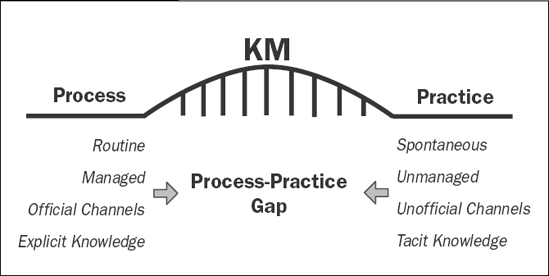3.6. Knowing Versus Doing
Virtually every knowledge worker and manager knows at least two methods of getting things done. Under normal circumstances, there's the official way, which includes going through the formal procedures of discussing, planning, and conceptualizing. Then there's the direct approach, which involves those who actually do the work. These knowledge workers can get something done when it would otherwise be impossible within the constraints imposed by the bureaucracy.
The difference in the two approaches can be described as the process-practice gap (see Exhibit 3.4). Process is routine, managed, official, and based on explicit knowledge. Practice, in contrast, is spontaneous; it sidesteps management and official channels and is based on tacit knowledge and personal connections.
As shown in the exhibit, the role of Knowledge Management is to bridge the process-practice gap. With a KM process in place, best practices quickly become new, standardized processes.
EXHIBIT 3.4. EXHIBIT 3.4

Get Essentials of Knowledge Management now with the O’Reilly learning platform.
O’Reilly members experience books, live events, courses curated by job role, and more from O’Reilly and nearly 200 top publishers.

